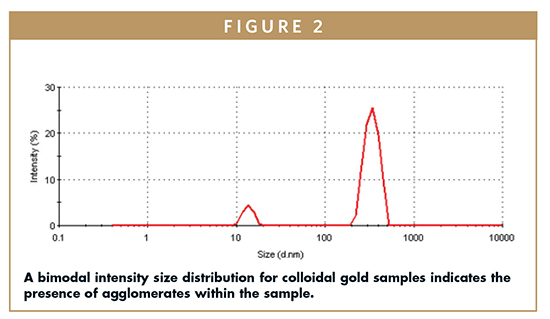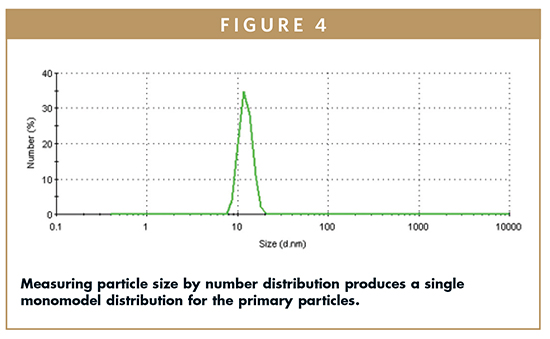Issue:March 2015
DYNAMIC LIGHT SCATTERING - Colloidal Gold: The Gold Standard for Drug Delivery?
INTRODUCTION
Today, the maturation of a decade’s worth of investment into nanotechnology is seeing nanomedical materials steadily emerge into clinical and medical practice. In commercial terms, the result of this carefully fostered research is that by 2015, the market for biomedical nanotechnology is expected to exceed $70 billion.1 In practical terms, this suggests a potentially transformative shift in the way diseases are targeted and treated.
Nanosized colloidal gold has great potential in multiple therapeutic and biotechnology applications. Taking drug delivery as an example, manipulation of the unique chemical, physical, and electronic properties of colloidal gold enables researchers to develop drug-nanoparticle conjugates for targeted drug delivery, improving a drug’s biodistribution and pharmacokinetics within specific biological targets, such as diseased tissue or cancerous cells. In this way, gold nanoparticles are set to play an important role as a platform for novel intracellular delivery vehicles and controlling nanoparticle size throughout the formulation process, which is crucial to defining this functionality.
This article explores the importance of particle size in biomedical nanotechnology. Experimental data are presented to illustrate how advanced Dynamic Light Scattering (DLS) techniques deliver these measurements for colloidal gold in the nanosized and sub-nanosized ranges.
ALL THAT GLITTERS: A BRIEF HISTORY OF GOLD THERAPY
Belief in the therapeutic properties of gold can be traced back to ancient times. However, it wasn’t until the 18th century that the antibacterial properties of gold cyano salts were discovered. Fast forward another 100 years, and gold salts are now routinely administered for the treatment and management of rheumatic arthritis. Beyond these conventional therapies, modern interest in gold lies in its colloidal form.
A number of properties of colloidal gold make it well-suited for nanomaterial-based clinical applications. Its chemical and physical inertness ensure the material is toxicologically safe in vivo, while its fine size allows particles to cross a cell membrane without harming the cell. Furthermore, gold nanoparticles suspended within aqueous media form negatively charged ions that have a strong affinity for biological macromolecules, such as proteins and antibodies, which form biological ligands around the ion. These unique physical properties are currently being exploited for a variety of biomedical applications, including their use as imaging probes, diagnostic agents, and for advanced drug delivery. In this last area, gold nanoparticles are being developed to provide sophisticated delivery mechanisms for a range of conventional and novel treatments, from oral insulin administration to targeted cancer drugs and DNA conjugates for advanced gene therapies.
As with all particulate therapeutics, the pharmacokinetic properties of colloidal gold conjugates, such as bioavailability and clinical efficacy, are strongly influenced by particle size. Controlling the particle size of colloidal gold is therefore of great importance to ensure treatments meet performance and safety criteria in vivo. Particle characterization forms an important aspect of nanoparticle R&D and QC in which routine analysis is performed during intermediary and endpoint formulation stages to ensure particles are homogenous in diameter and there are no aggregates present in the dispersion. This calls for a powerful analytical technique that combines the robust and reliable characterization of particles within the entire sample with the efficiency demanded of routine analysis. Dynamic Light Scattering (DLS) is emerging as a highly effective technique to meet these industrial needs.
INTRODUCING DYNAMIC LIGHT SCATTERING
Several particle characterization techniques are used routinely within nanoparticle development. Particle visualization with electron microscopy is widely applied to deliver detailed insight into the structure and morphology of individual particles within the system (Figure 1). However, the technique has several limitations that restrict its practical application for routine analysis.
Electron microscopy only measures a small sample distribution and derives a number-based mean particle size measurement. Colloidal gold products consist of tens of thousands of particles, and so deducing overall product homogeneity or aggregate concentration from this data may be a statistically poor approach. As the presence of even low level aggregates can impact clinical efficacy, and are often indicative of processing or formulation issues, electron microscopy alone cannot be relied upon for QC. Moreover, electron microscopy often requires lengthy and intensive analysis, both in terms of cost and operator effort. A complementary ensemble technique that determines a volume- or mass-based size distribution of the particles in relation to the entire dispersion is therefore desirable to identify out-of-specification aggregates.
Dynamic Light Scattering (DLS) is a non-invasive technique that is used routinely for the analysis of dispersed particles and colloidal nanoparticles.2 DLS measures the time-dependent fluctuations in the intensity of scattered light from a suspension of particles undergoing random Brownian motion. Analysis of these intensity fluctuations allows determination of the diffusion coefficients, which in turn yield the particle size through the Stokes-Einstein equation.3
Several advances in DLS technology over recent years have improved the sensitivity and resolution of DLS measurements within the nanosize region. For instance, patented non-invasive backscattering (NIBS) optics now enables particle size measurements across a dynamic size range, from 0.3 nm to 10 microns in diameter within solutions from 0.1 ppm to 40% w/v in concentration.4 Rapid data acquisition and nondestructive sample recovery means DLS can be efficiently employed for both “peace-of-mind” studies as well as more formal QC.
The following case study explores the benefits of using DLS for nanoparticle characterization. Experimental data using colloidal gold highlights the differences in the results that might be obtained with DLS compared to electron microscopy and how this can be used to gain a better understanding of the nanoparticle system.
CASE STUDY: CHARACTERIZATION OF COLLOIDAL GOLD USING DLS
An experiment was carried out using an advanced DLS system (Zetasizer Nano S, Malvern Instruments, UK) to measure a sample of colloidal gold. All measurements were performed at 25 degrees C with the DLS system operating at 633 nm with an avalanche photodiode (APD) detector. The scattered light was detected at an angle of 173 degrees.2
Figure 2 shows the intensity particle size distribution obtained for the colloidal gold sample. The plot shows the relative percentage of light scattering by the particle against various size classes. The two distinct peaks at 13.6 nm and 339 nm indicate a bimodal distribution and imply the presence of aggregates within the samples.
From the relative intensities of the size distribution peaks, it first appears that there is a high number of aggregates within the sample. However, when this is converted to a volume-based distribution, as shown in Figure 3, it becomes clear that, in reality, the concentration of aggregates is relatively low. This transformation is performed by smart instrument software using the Mie theory of light scattering and particle refractive index and absorption. The volume size distribution shows that, on a mass basis, the majority of the sample consists of small particles around 13 nm and indicates a 9:1 ratio of primary particles to aggregates.
Comparing volume- or intensity-based particle sizing to number-based techniques reveals the value of supplementing conventional nanoparticle analysis with DLS. Conversion of the volume-based distribution into a number-based distribution is shown in Figure 4. As the sample contains very few aggregates, the number distribution is monomodal with a peak mean at 12.4 and considers only the primary particles. The result suggests that if this sample were to be characterized using a technique, such as electron microscopy, the vast majority of particles present would be small ones, making it very difficult to accurately extrapolate the overall concentration of aggregates.
Dynamic light scattering is a low resolution technique, capable of producing discrete distributions for materials that differ in size by more than a factor of 3. However, through smart data interpretation the technique can still deliver insight into systems with very narrow size distributions. For instance, a mixture of single particles and aggregates made of 2, 3, or 4 particles would be expected to give a broad single peak. As the larger particles scatter the majority of the light, aggregate species have greater influence over the peak than primary particles. The z-average diameter and polydispersity index values are sensitive to the presence of aggregates and are a good indication of their presence within the samples. The z-average diameter is the mean intensity-weighted hydrodynamic diameter and the polydispersity index is an estimate of the width of the distribution. Both of these parameters are calculated by the system in accordance to the International Standard on dynamic light scattering ISO22412.5
Dynamic Light Scattering provides a solution to the need within nanoparticle development and formulation for quick and reliable quality control analysis that encompasses the entire sample. By generating a particle size distribution for the whole dispersion, DLS enables users to quickly identify the presence of aggregates or, out of specification, particles that may otherwise be overlooked with number-based particle sizing techniques alone. Today, the availability of this high-end technology within commercial DLS systems is delivering the high sensitivity, accuracy, and resolution required for homogeneity and aggregation studies of nanoparticles within advanced biomedical applications.
To view this issue and all back issues online, please visit www.drug-dev.com.
REFERENCES
1. Aggarwal S. What’s fueling the biotech engine-2008. Nat. Biotechnol. 2009;27(11):987-999.
2. Characterization of Colloidal Gold Using Dynamic Light Scattering – Malvern Instruments application note, image courtesy of Dr. Michael Natan from the Department of Chemistry at Penn State University. http://www.malvern.com/ColloidalGoldCharacterization accessed 19/09/2014.
3. An Introduction to Dispersion Technology system – Malvern Instruments Webinar http://www.malvern.com/DispersionTechnology Introduction accessed 23/09/2014.
4. Fiber optic device for detecting the scattered light or fluorescent light from a suspension. Patent No. US 6,016195, EU 0884580, DE 19725211, JP 2,911,877.
5. International Standard 22412:2008 Particle size analysis – dynamic light scattering (DLS).

Stephen Ball is Product Marketing Manager, Nanoparticle and Molecular Characterization, at Malvern Instruments. He earned a degree in Computer Aided Chemistry from the University of Surrey, UK, which included a year in industry working as a Research Chemist for the Dow Chemical Company in Horgen, Switzerland. Before joining Malvern Instruments, he worked for Polymer Laboratories as an Applications Chemist, then took on a marketing position as a Product Manager for light scattering instrumentation at Agilent Technologies.
Total Page Views: 7226













